
The Nymphaeales are an order of flowering plants, consisting of three families of aquatic plants, the Hydatellaceae, the Cabombaceae, and the Nymphaeaceae. It is one of the three orders of basal angiosperms, an early-diverging grade of flowering plants. At least 10 morphological characters unite the Nymphaeales. One of the traits is the absence of a vascular cambium, which is required to produce both xylem (wood) and phloem, which therefore are missing. Molecular synapomorphies are also known.

Gunnera is the sole genus of herbaceous flowering plants in the family Gunneraceae, which contains 63 species. Some species in this genus, namely those in the subgenus Panke, have extremely large leaves. Species in the genus are variously native to Latin America, Australia, New Zealand, Papuasia, Hawaii, insular Southeast Asia, Africa, and Madagascar. The stalks of some species are edible.

The Crato Formation is a geologic formation of Early Cretaceous (Aptian) age in northeastern Brazil's Araripe Basin. It is an important Lagerstätte for palaeontologists. The strata were laid down mostly during the Aptian age, about 113 million years ago. It thought to have been deposited in a semi-arid lacustrine wetland environment.

Pandanales, the pandans or screw-pines, is an order of flowering plants placed in the monocot clade in the Angiosperm Phylogeny Group and Angiosperm Phylogeny Web systems. Within the monocots Pandanales are grouped in the lilioid monocots where they are in a sister group relationship with the Dioscoreales. Historically the order has consisted of a number of different families in different systems but modern classification of the order is based primarily on molecular phylogenetics despite diverse morphology which previously placed many of the families in other groupings based on apparent similarity. Members of the order have a subtropical distribution and includes trees, shrubs, and vines as well as herbaceous plants. The order consists of 5 families, 36 genera and about 1,610 species.

Welwitschiaceae is a family of plants of the order Gnetales with one living species, Welwitschia mirabilis, found in southwestern Africa. Three fossil genera have been recovered from the Crato Formation – late Aptian strata located in the Araripe Basin in northeastern Brazil, with one of these also being known from the early Late Cretaceous (Cenomanian-Turonian) Akrabou Formation of Morocco.

The Cabombaceae are a family of aquatic, herbaceous flowering plants. A common name for its species is water shield. The family is recognised as distinct in the Angiosperm Phylogeny Group IV system (2016). The family consists of two genera of aquatic plants, Brasenia and Cabomba, totalling six species.

Archaeamphora longicervia is a fossil plant species, the only member of the hypothetical genus Archaeamphora. Fossil material assigned to this taxon originates from the Yixian Formation of northeastern China, dated to the Early Cretaceous.

Archaefructus is an extinct genus of herbaceous aquatic seed plants with three known species. Fossil material assigned to this genus originates from the Yixian Formation in northeastern China, originally dated as late Jurassic but now understood to be approximately 125 million years old, or early Cretaceous in age. Even with its revised age, Archaefructus has been proposed to be one of the earliest known genera of flowering plants.
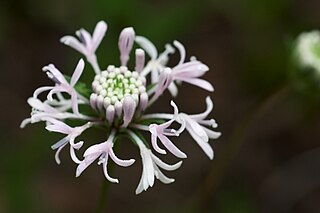
Marshallia mohrii, or Mohr's Barbara's buttons or Coosa Barbara's buttons, is a perennial herb species, endemic to the Southeastern United States, in several locations in Alabama, Georgia, and Florida. The first recorded discovery of the species was in 1882 by Dr. Charles Mohr, hence the botanical species name and common name.
Paeonia sterniana is a perennial, herbaceous peony of approximately 45 cm high in cultivation, with white or sometimes pinkish flowers. It grows in the wild in southeastern Tibet. This peony is very rare in cultivation. It produces blue seeds in autumn. Its common name in Chinese is 白花芍药, which means "white peony".

Paeonia broteri is a perennial, herbaceous species of peony. It is an endemic species of the Iberian Peninsula. It bears rose-pink highly fragrant flowers about 12 cm wide and glossy green leaves. It reaches up to 40 centimetres (16 in) in height.

Paeonia clusii is a relatively low (25–50 cm) species of herbaceous peony with scented, white or pink flowers of up to 12 cm in diameter. In the wild, the species can only be found on the islands of Crete and Karpathos, and Rhodes. It has pinkish-purple stem up to 30 cm long and glaucous dissected leaves. P. clusii blooms in mid-spring.
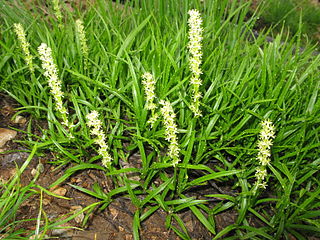
Japonolirion is a genus of plants in the family Petrosaviaceae. There is only one known species, Japonolirion osense, endemic to Japan. It is found in grasslands, wetlands and alpine meadows.
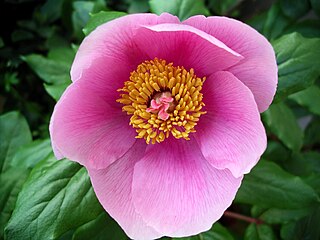
Paeonia corsica, also known as the Corsican peony, is a perennial herbaceous plant of 35–80 cm (14–31 in) high that belongs to the peonies. It naturally occurs on Corsica, Sardinia, on the Ionian islands and in western Greece. It has hairless green to purple stems, and the lower leaves consist mostly of nine leaflets with undersides which may carry felty hairs or are hairless. Its flowers have pink petals and purple filaments. Its vernacular name in Italian is peonia Corsa, and in French pivoine de Corse, both meaning "Corsican peony".
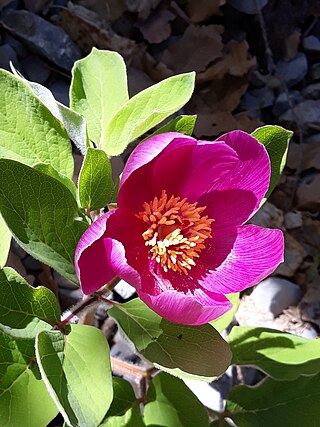
Paeonia algeriensis, also known as the Algerian peony, is a herbaceous species of peony that naturally occurs in the coastal mountain range of Algeria (Kabylie). It has solitary flowers with pink to magenta petals and one or two carpels per flower, that develop into follicles of about 5 cm long.

The Santana Group is a geologic group, formerly included as the middle part of the Araripe Group, in the Araripe Basin of northeastern Brazil. The group comprises the Crato, Ipubi and Romualdo Formations and is dated to the Aptian to Albian stages of the Early Cretaceous. The formations of the group were deposited in a lacustrine to subtidal shallow marine environment in the Araripe rift basin.
This list of 2013 in paleobotany records new fossil plant taxa that were described during 2013, as well as other significant discoveries and events related to paleobotany that occurred in the year.
Araucarites is an extinct genus of conifer, used to refer to female conifer cones that resemble those of the family Araucariaceae. Species assigned to the genus lived in the Permian to Eocene and have been found worldwide.

Jaguariba wiersemana was a species of herbaceous, rhizomatous, aquatic plant, which occurred in the early Cretaceous period of Northern Gondwana.
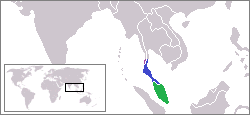
Barclaya panchorensis is a species of perennial aquatic plant endemic to Peninsular Malaysia.
















